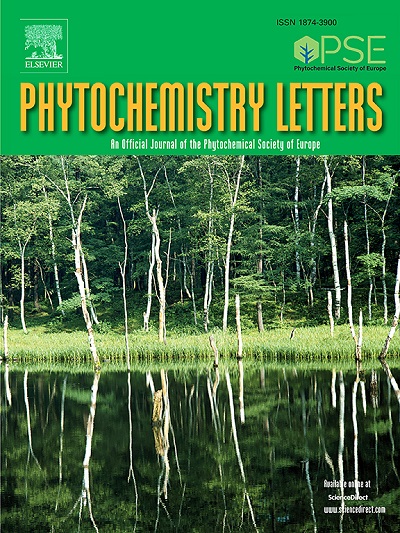内生菌索达里真菌(Sordariomycetes sp.
IF 1.3
4区 生物学
Q4 CHEMISTRY, MEDICINAL
引用次数: 0
摘要
通过核磁共振、红外光谱、紫外光谱和电化学检测等方法,阐明了两种新型黄色色素--7,8-二氢-12-O-甲基卵磷脂内酯 B (1)和 12-O-甲基卵磷脂内酯 B (2),以及两种已知化合物--卵磷脂内酯 B (3)和茴芹二醇 (4)。通过核磁共振、红外线、紫外线、质谱和电化学检测,阐明了新化合物的结构,包括其绝对构型。此外,还对分离出的化合物的细胞毒性和抗菌活性进行了评估。化合物 1 对 HL60 细胞具有细胞毒性,IC50 为 15.8 μM,而化合物 3 则具有中等细胞毒性。化合物 3 在 50 µg/disk 的浓度下可抑制枯草杆菌,化合物 4 在 50 µg/disk 的浓度下可抑制热带念珠菌、枯草杆菌和黑曲霉。本文章由计算机程序翻译,如有差异,请以英文原文为准。
New yellow pigments related to the pitholides from the Endophyte Sordariomycetes sp.
Two novel yellow pigments, 7,8-dihydro-12-O-methylpitholide B (1) and 12-O-methylpitholide B (2), and two known compounds, pitholide B (3) and anishidiol (4), were isolated from an endophytic strain of Sordariomycetes sp. S-3. The structures of the new compounds, including their absolute configurations, were elucidated by nuclear magnetic resonance, infrared, ultraviolet, mass spectrometry, and electrochemical detection. The cytotoxicity and antimicrobial activities of the isolated compounds were also evaluated. Compound 1 exhibited cytotoxicity against HL60 cells with an IC50 of 15.8 μM, whereas compound 3 exhibited moderate cytotoxicity. Compound 3 inhibited B. subtilis at 50 µg/disk, and 4 inhibited Candida tropicalis, B. subtilis, and Aspergillus niger at 50 µg/disk.
求助全文
通过发布文献求助,成功后即可免费获取论文全文。
去求助
来源期刊

Phytochemistry Letters
生物-生化与分子生物学
CiteScore
3.00
自引率
11.80%
发文量
190
审稿时长
34 days
期刊介绍:
Phytochemistry Letters invites rapid communications on all aspects of natural product research including:
• Structural elucidation of natural products
• Analytical evaluation of herbal medicines
• Clinical efficacy, safety and pharmacovigilance of herbal medicines
• Natural product biosynthesis
• Natural product synthesis and chemical modification
• Natural product metabolism
• Chemical ecology
• Biotechnology
• Bioassay-guided isolation
• Pharmacognosy
• Pharmacology of natural products
• Metabolomics
• Ethnobotany and traditional usage
• Genetics of natural products
Manuscripts that detail the isolation of just one new compound are not substantial enough to be sent out of review and are out of scope. Furthermore, where pharmacology has been performed on one new compound to increase the amount of novel data, the pharmacology must be substantial and/or related to the medicinal use of the producing organism.
 求助内容:
求助内容: 应助结果提醒方式:
应助结果提醒方式:


